
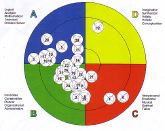
An example of a team's "thinking profile".
How does your team think?
 |
Contact
Bruce Holland
| mob+6421 620 456 |
| Bruce.Holland@virtual.co.nz |
 |
Herrmann's Brain Dominance Instrument (HBDI)
"It's like looking at our organisation under a microscope" - Satisfied customer.
THE BUSINESS CASE FOR HBDI
People are different. Research with hundreds of thousands of people show there are four 'species' of people living side-by-side on this planet. Without help they simply don't understand each other. HBDI is the tool the build this understanding.
Two things are needed for personal and business success: self-knowledge and knowledge of others. HBDI improves both. Self-knowledge is the starting point because it leads to increased self-esteem and self-improvement. Knowledge of others is important because it is the key to better communication, trust, working relationships and influencing.
When we have asked users to develop the business case for using Herrmann's Brain Dominance Instrument, the factors they emphasise depend on their personal brain dominance. For example the benefits BLUE thinkers emphasise are performance improvements, effectiveness, increased sales, cost savings, reduced attrition. The benefits GREEN thinkers emphasise are more efficiency, time saving and improved processes as people work together better. The benefits RED thinkers emphasise are improved relationships, coaching, teamwork and better training. The benefits YELLOW thinkers emphasise are more creativity, more options, and new ways of working that result from understanding each others strengths.
WHO USES HBDI?
Fortune 500 companies use HBDI and so should you.
- 77.4% of the Fortune 500 companies have used HBDI in the last 5 years
- 87.5% of the top 200 have used HBDI in the last 5 years
- 93% of the top 100 have used HBDI in the last 5 years
- And 100% of the top 10 have used HBDI in the last 5 years!
|
Herrmann explains why we are all so different, and how to get the best out of people. Treat them the same and you'll get grey, treat them as they want and you'll get brilliant colour. |
THE MODEL
Herrmann's Brain Dominance Instrument (HBDI) is based on Nobel-Prize winning research and has been the subject of over 50 Ph.D studies. Ned Herrmann's brilliance is in bringing together the work of two giants in brain research. These are Roger Sperry and Paul Mc Lean and forming a model based on the four parts of our brain.
Roger Sperry's Left Brain / Right Brain Split
Roger Sperry showed the left side of the brain tends to take in information using the five senses and is concerned with language, words, analysis, and figures. The right side tends to take in information using the sixth sense (intuition) and is concerned with patterns, relationships, art, and music. We all use both sides but some prefer their left brain while others prefer their right brain and this makes us who we are.
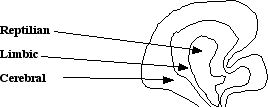
Paul McLean/s Theory
Paul McLean looked at the brain as a cross-section (see chart left). In terms of depth, there are three layers: 1. a lizard's brain (involuntary body functions such as heart beat and basic reflexes), 2. an inner brain (called the limbic brain which controls intuition, emotions and feelings) and 3. an outer brain (called the cerebral brain which controls thinking and reasoning). We all use both inner and outer parts of our brain but some prefer their outer brain while others prefer their inner brain and again this makes us who we are.
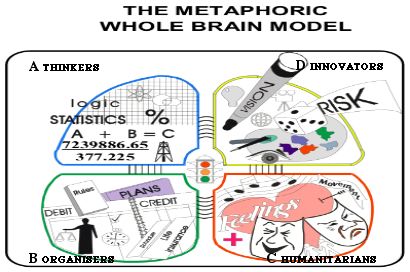
The Four Dimensions
By drawing these four dimensions Herrmann has created a very useful way of thinking about the human mind, human behaviour and human organisations. Every person and every human organisation can be characterised according to their preference towards each of the four dimensions or segments.
Brain theory is fundamental to understanding human nature, because it explains why we are all so different, and why we often have such fundamental misunderstandings over things which one would expect we should agree about. It's the reason why we communicate far more easily with some people (similar types) than others. It's the reason why we tend to marry different types - for completeness. It's the reason why we can be so clever and so dumb at the same time depending on what we are doing and who we are working with.
THE PRODUCT
Individual Profile
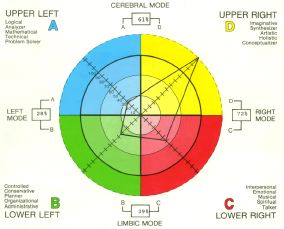
Each person gets a personalised profile (like chart left) showing their thinking preferences plus a four-part book to help them make the most of their thinking preferences and talents and provides a personal development program. They also receive access to Herrmann International's e-learning modules.
Individual outputs include:
- Each person understands their thinking preference under normal conditions and under stress
- Each person understands their basic need, how they like to be appreciated and what frustrates them
- Each person understands their strengths and how to play to them
- Each person understands their weaknesses and how to cover them
- Each person gains a deeper understanding of the work they do best and how they can contribute better to the organisation
- Each person ends up with a language or way of talking about deeper issues that English does not deal with well.
Team Profile
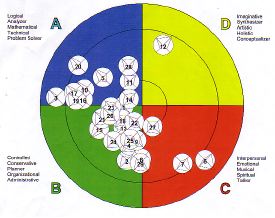
Each team gets a Group Profile showing the position of each person within the Team as a small circle. This analysis is vital for understanding the team, why the culture is as it is and how to improve it. Typically people who previously misunderstood each other become natural partners by combining their differences. People who are diagonally opposite each other often have real issues understanding each other or valuing each other, however, when they understand HBDI the penny drops as they realise that together they can be far more successful. What was previously a problem becomes a benefit.
The example (left) is of a Finance Team. It shows their heavy weighting in Blue (Thinkers) and Green (Organisers). When this team first saw its profile they suddenly realised how frightening and tough and numerate they must look to the rest of the organisation that was essentially Red (Humanitarian). Because of their weighting towards Green (organising) they agreed they needed to be careful not to create systems for the sake of systems or follow procedures for the sake of procedures. Because of their weakness in Yellow (Innovation) they needed to put sufficient time into thinking about why they are producing their figures and find innovative ways to improve. The Finance Team was also very weak in Red (Humanitarian) thinking so they were not think carefully about the impact their figures were having on the culture of the organisation, nor how to deliver the figures in a way that was acceptable to their Red readers. Also there was no one thinking about team relationships, customer service or the affect their systems were having on people in the organisation.
Other Team Profile Charts include:
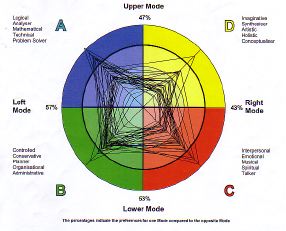
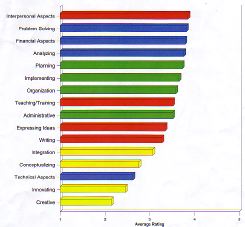
Team outputs include:
- Each person understands their teammates better including: each person's basic drivers, basic needs, how to better communicate and influence each; what frustrates each person and how to get the best out of each person by tapping into their strengths and covering their weaknesses.
- Increased trust and respect between people, and faster work flow. This happens because each person will learn how to flex their approach to match exactly the colour of their customers and colleagues; this significantly reduces the potential for interpersonal misunderstandings and mis-communications.
- A more harmonious workplace and reduced complaints from customers. This happens because each person will develop their understanding of what frustrates different types and how to anticipate this and reduce it.
- Improved communications and reduced wasted effort. This happens because each person will learn how to communicate more effectively and flex to different types.
- Better working relationships between teams. This happens because each team will understand its thinking preference and how this is seen within the organisation and outside.
- Better understanding of the customers' needs and improve delivery. This happens because each team will identify its major customers and explore their likely thinking styles and how to approach them and communicate with them most effectively.
- The group ends up with a language or way of talking about deeper issues that English does not deal with well.
- Each person will better understand their manager and how to approach her and communicate with her most effectively.
A TYPICAL PROGRAM
HBDI can be used as a half-day workshop or an intensive week long program; however, the most common format is either a two or three half-day workshop depending on what you what to achieve:
- A half-day workshop is Understanding Ourselves using Herrmann's Thinking Preferences. It has a more internal focus (on self and our team).
- A half-day workshop is Colour Your Customers & Colleagues. It has a more external focus (on others) and how to relate, understand and communicate with them more effectively.
- A half-day workshop for helping people work more effectively in teams. It helps team members understand their strengths and the strengths of their colleagues so the team can benefit from the overall genius within the team.
PROBABLE OUTCOMES OF USING HBDI
HBDI resolves several high risk issues which you simply can not afford to get wrong. They are usually resolved by intuition. Herrmann adds certainty and reduces risks of getting them wrong. Otherwise it's like having brain surgery without a CT scan.
Some of the outcomes of HBDI are:
- To know ourselves better, including our strengths so we can exploit them; our weaknesses so we can train and develop ourselves to overcome them; how to plan our careers and the sort of work we should do and the sort of people we should have around us to support us; and how to identify our Genius Factor.
- To know teammates better and improve team trust, communication and cooperation.
- To communicate better, including how to understand other people and communicate more effectively with them.
- To do better presentations. When it comes to doing presentations, it's vital that you understand the thinking preference of the decision-maker, and that you communicate in a way which flexes to their communication style rather than the one that you prefer.
- To understand our customers at a deeper level so we can understand and deliver customer service that exactly fits their needs according to their colour.
- To build better teams that reflect all thinking preferences. There is a great deal of research that shows the importance of balanced teams. It shows that Herrmann improves the effectiveness and productivity of groups dramatically!
- To design better training that significantly reduces the amount of time required.
- To write to specific audiences in a language that will communicate things that are important to that audience.
- To identify talent in people that often they did not know they had themselves. Research shows that the ability to identify talent is the only common factor that distinguishes successful leaders from other managers.
- To design the Culture that is appropriate for your Value Proposition and Strategy.
- Designing Jobs that match people and their talents to the work that has to be done.
- Decision Making.
- Aligning the organisation to match the market place.
- Improves interpersonal understanding and resolve interpersonal conflicts.
SUPPORTING MATERIAL
- A short YouTube introduction to HBDI and why it's important to you...
- Some of the major lessons from Herrmann include...
- Comparision with Myers Briggs...
- Known uses of Herrmann...
CLIENT COMMENTS
For a list of Client Comments
PRODUCT SUPPORT
This product based on Herrmann's Brain Dominance Index (HBDI) is supported by Bruce Holland with help where required from other members of the Virtual Group Business Consultants. Bruce is a specialist in Herrmann Thinking Preferences in Wellington, nationally and internationally. He specialises in using Herrmann's Brain Dominance Instrument (HBDI) in the public sector and other large private sector organisations.
GUARANTEE
All work undertaken by Bruce Holland is guaranteed. If at the end of the program the client doesn't feel that they have received value for money, they may adjust the bill and pay an amount equal to the value they feel they received.
NEXT STEP
For more information about how you can use HBDI give the Virtual Manager a call or ring Bruce Holland direct.
Bruce Holland
Phone +6421 620456
Bruce.holland@virtual.co.nz.
Key words: Leadership, leadership development, leadership management, leadership training, leadership program, leadership skills


